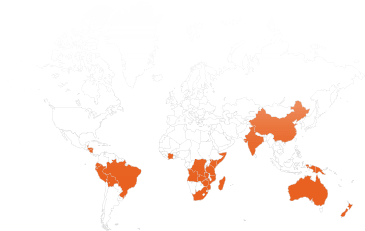The Cassowary Coast in North Queensland Australia
The Cassowary Coast in North Queensland Australia- Home to Australia’s most imposing bird, the project is designed to help restore habitat for the threatened Cassowary as well as the Mahogany Glider.Cassowary Coast in North Queensland Australia
- Volunteer to create habitat for threatened species such as the Southern Cassowary and Mahogany Glider.
- Enjoy a rainforest walk and lookout at Murray Falls inside the Girramay National Park
- Spot typical Aussie wildlife like the threatened Southern Cassowary and the Estuarine Crocodiles.
- Discover the many tropical rainforests and beaches of the Cassowary Coast, including the palm-fringed stretch of Mission Beach.
- Explore the swimming hole at Babinda Boulders, and learn of the Traditional Aboriginal Dreamtime Story
Sample Itinerary
Note that itineraries, activities and visited places may vary based on seasonal weather conditions.
Day 1 – Meet the local team at 8am at the meetup point in Cairns. From there, you will travel south to the Cassowary Coast, stopping to look for estuarine crocodiles in the Johnstone River. Your first conservation efforts will be at the Johnstone Landcare nursery helping propagate native plant seedlings. After lunch, you will get a guided tour of the Cassowary Environment Information Centre before settling at the campsite located between the Tully and Hull Rivers. You will be provided with Lunch and Dinner.
Day 2 and 3 – You will be helping a local organization close to the Tully River with their revegetation activities including tree planting, mulching and some weed control. You will be provided with Breakfast, Lunch and Dinner.
Day 4 – You will continue to carry out conservation activities near the Tully River and then enjoy lunch by Murray Falls within Girramay National Park. You will then take a nature walk through wet scerophyll forest to lookout above the falls. You will be able to relax the entire afternoon and enjoy the spectacular water-sculpted rocks and crystal-clear pools. You will be provided with Breakfast, Lunch and Dinner.
Day 5 – Head back to Cairns via the Nursery again with a stop along the way to the must-do Babinda Boulers where you can swim in clear and cool creek waters, explore the rainforest and learn about Aboriginal Dreamtime story of the scared site. You will be back to Cairns for 4pm and will be provided with Breakfast and Lunch.
Conservation Impact
The Cassowary Coast of Tropical North Queensland Australia is nestled between two World Heritage Areas: the Wet Tropics Rainforest and the Great Barrier Reef. As a result, it holds unique conservation values, including the largest single stand of Licuala Palm Forest in Australia. The forest is the habitat for 36% of Australia’s bird species and is Australia’s highest concentration of cassowaries.
The Southern Cassowary is one of Australia’s most imposing birds. It is known as large, colourful, and flightless. It is found only in the dense tropical rainforests of north east Queensland. The clearing and fragmentation of rainforest, as well as the increased mortality from being hit by cars or caught by dogs have reduced cassowary numbers to perhaps as few as around 2000. The specie is threatened with extinction.
The Southern Cassowary Casuarius casuarius belongs to an ancient group of flightless birds that includes Australia’s emu, Africa’s ostrich and New Zealand’s kiwi and the now-extinct moa. As tall as an adult human (up to 170 centimetres), the female Southern Cassowary is Australia’s heaviest bird. During this project, you will assist with hands-on seasonal conservation projects on a private land to increase cassowary habitat in the area. The aim is to improve the population status of this threatened species.
